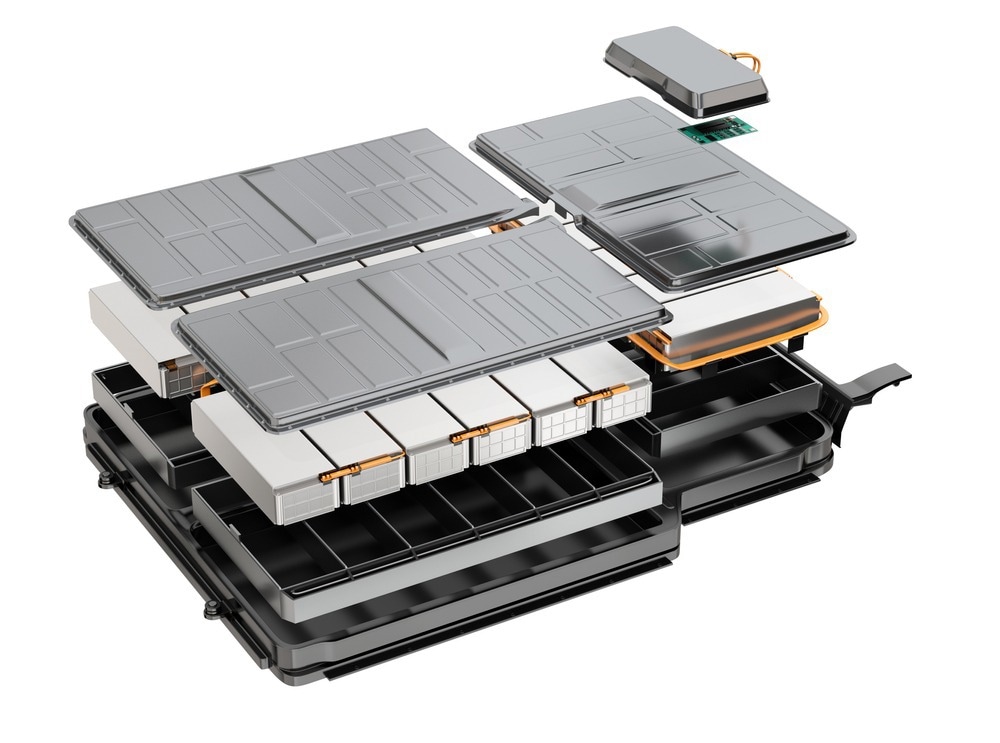A researcher at the University of Central Florida has created technology that could avoid electric vehicle fires, such as those caused by hurricane seawater floods.

Image Credit: Chesky/Shutterstock.com
The aqueous battery technology substitutes the volatile and highly combustible organic solvents found in lithium-ion batteries in electric vehicles with salt water to produce a battery that is safer, faster charging, just as strong, and will not short circuit during floods.
The findings are published in the journal Nature Communications.
During Hurricane Ian, a lot of electric cars caught fire after they were soaked in floodwater. That is because the saltwater corrodes the battery and causes a short circuit, which ignites the flammable solvents and other components. Our battery uses saltwater as an electrolyte, eliminating the highly volatile solvents.
Yang Yang, Associate Professor, NanoScience Technology Center, University of Central Florida
The battery’s innovative nano-engineering, which enables the battery to overcome previous aqueous batteries’ drawbacks, like slow charging periods and poor stability, is also critical to its design.
The UCF-designed battery charges quickly, attaining full charge in 3 minutes as opposed to the hours required by lithium-ion batteries.
Yang is an expert in designing materials for safer renewable energy devices such as batteries.
Saltwater Electrical Vehicle Fires
Electric vehicle fires caused by saltwater floods were reported during Hurricane Sandy in 2012 and Hurricane Isaias in 2020.
As a result, the National Highway Traffic Safety Administration and the US Fire Administration have established unique guidelines for responding to electric vehicle fires caused by saltwater flooding.
The International Association of Fire Chiefs recommends that firefighters acquire a constant and sustainable water supply of 3,000 to 8,000 gallons to put out fires.
The US Fire Administration revealed that after Hurricane Ian, at least 12 electric vehicle fires occurred in Florida’s Collier and Lee counties, where many vehicles were at least partially submerged in saltwater.
Designing the Battery
Previous iterations of aqueous batteries have issues with low energy output, instability, the development of hazardous metallic dendrites on the negative electrode, and corrosion.
The UCF researchers were able to construct a dual-cation battery that stores more energy by employing saltwater as the battery's liquid electrolyte and naturally occurring metal ions found in saltwater, like sodium, potassium, calcium, and magnesium. They were able to overcome the sluggishness of earlier single-cation aqueous battery designs because of this implementation.
The researchers created a forest-like 3D zinc-copper anode with a thin zinc-oxide protective layer on top to address issues with instability, dendrite growth, and corrosion.
The new, nano-engineered surface, which resembles a birds-eye view of a forest, enables scientists to accurately control electrochemical reactions, enhancing the battery’s stability and charging speed.
Moreover, optical microscopy revealed that the zinc-oxide layer inhibited zinc dendritic growth.
These batteries using the novel materials developed in my lab will remain safe even if they are used improperly or are flooded in saltwater. Our work can help improve electric vehicle technology and continue to advance it as reliable and safe form of travel.
Yang Yang, Associate Professor, NanoScience Technology Center, University of Central Florida
The patent-pending technology is available for license through the UCF’s Office of Technology Transfer.
The study was funded by the US National Science Foundation and American Chemical Society Petroleum Research Fund.
Journal Reference:
Tian, H., et al. (2022) Three-dimensional Zn-based alloys for dendrite-free aqueous Zn battery in dual-cation electrolytes. Nature Communications. doi.org/10.1038/s41467-022-35618-2.